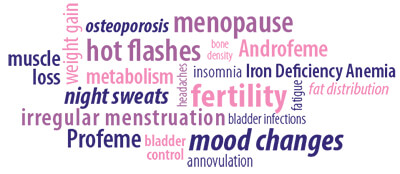What is Perimenopause?
Perimenopause is the phase during which the female reproductive system winds down approaching menopause. (‘Peri’ means around and ‘menopause’ means cessation of monthly periods.) Perimeno- pausal ovaries no longer produce a predictable amount of the hor- mones progesterone, testosterone and estrogen. Perimenopause is an expected, natural part of ageing, not a disease.
Some women have no or very mild perimenopausal symptoms. However, in many women ovarian insufficiency leads to these Perimenopause side effects:
- insomnia,
- fatigue,
- weight gain,
- forgetfulness,
- mood swings,
- menstrual problems and
- loss of sexual desire.
From the late thirties onwards, very subtle body changes take place triggered by gradual hormonal shifts. Women usually experience noticeable perimenopausal symptoms of varying intensity from the early forties until the onset of menopause. In about 20% of women acute symptoms affecting their quality-of-life may last for 3 to 6 years if steps are not taken to manage the symptoms. Perimenopausal symptoms are generally the result of estrogen dominance. Estrogen dominance is due to insufficient progesterone production from the ovaries to balance estrogen production.
Menopause occurs the day after your final period finishes, so it is diagnosed in hindsight. It is the definitive end of menstruation and fertility, when no menstrual periods have occurred for 12 consecutive months. (‘Mens’ is Greek for month and ‘pausis’ means cease.) Menopause is also called the change of life or climacteric. Many people use the term ‘menopause’ to also cover perimenopause, when
symptoms of the change of life begin, but this is incorrect terminology.
What are the signs and symptoms of perimenopause?
In women the overall symptoms of estrogen dominance are often nondescript
- a general malaise,
- a feeling that something is just not right,
- of not being on top of life and
- a general loss of confidence in one’s self and abilities.
Physically, mentally and emotionally the most common symptoms include:
- mood changes
- forgetfulness / memory blanks
- tiredness/ fatigue
- irritability / anxiety / anger
- sleep disturbances
- decreased concentration
- breast tenderness / soreness
- aches and pains
- fluid retention / bloating
- sugar cravings
- menstrual changes
- irregular, prolonged and/or heavy flow
- increased body fat / weight gain
- lowered sexual desire
Some perimenopausal women may experience only one or two of these symptoms whereas others may experience many.
This FREE downloadable Perimenopause booklet goes into more detail.
You can read more about Dealing with the Menopause years on our TestoMeds blog.
Understand more on perimenopause:
Signs and symptoms of perimenopause
Perimenopauuse menopause treatments & side effects
The information in this article has been taken with permission from the official Lawley booklet on Understanding Perimenopause.

